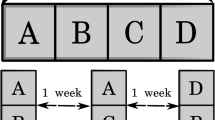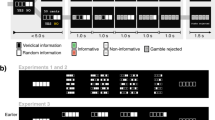Abstract
This study examined the role of contingencies and experimental context in human decision making. Twelve subjects participated across a series of conditions that provided response alternatives of a small, high-probability reinforcer (non-risky alternative) or a larger, low-probability reinforcer (risky alternative). A range of reinforcer amounts and probabilities were used in a discrete trial design with repeated trials across multiple sessions. The conditions of this study more closely modeled studies with nonhumans responding for food than studies with humans making decisions about hypothetical monetary amounts. Consistent with previous data, subjects displayed a strong preference for the non-risky response alternative, even when doing so resulted in lost earnings. The data support models of decision and risk that emphasize the subjective (rather than mathematically expected) value of reinforcers, and the data highlight the important role of reinforcement contingencies and context in risk-taking behavior.
Similar content being viewed by others
References
AMERICAN PSYCHIATRIC ASSOCIATION (1994). Diagnostic and Statistical Manual of Mental Disorders (4th ed.) (DSM IV). Washington, DC: APA Press.
CARACO, T., MARTINDALE, S., & WHITTAM, T. S. (1980). An empirical demonstration of risk-sensitive foraging preferences. Animal Behaviour, 28, 820–830.
DE VILLIERS, P. (1977). Choice in concurrent schedules and a quantitative formulation of the law of effect. In W. K. Honig & J. E. R. Staddon (Eds.), Handbook of operant behavior. Englewood Cliffs, NJ: Prentice-Hall.
FIRST, M. B., SPITZER, R. L., GIBBON, M., & WILLIAMS, J. B. W. (1996). Structured clinical interview for DSM-IV Axis I Disorders: Non-patient edition (SCID-NP, v. 2.0). New York: NY State Psychiatric Institute.
GOODIE, A. S., & FANTINO, E. (1995). An experimentally derived base-rate error in humans. Psychological Science, 6, 101–106.
HAMM, S. L., & SHETTLEWORTH, S. J. (1987). Risk aversion in pigeons. Journal of Experimental Psychology: Animal Behavior Processes, 13, 376–383.
HASTJARJO, T., SILBERBERG, A., & HURSH, S. R. (1990). Risky choice as a function of amount and variance in food supply. Journal of the Experimental Analysis of Behavior, 53, 155–162.
HERRNSTEIN, R. J. (1997). In H. Rachlin & D. I. Laibson (Eds.), The matching law. Cambridge, MA: The Harvard University Press.
HOUSTON, A. I. (1991). Risk-sensitive foraging theory and operant psychology. Journal of the Experimental Analysis of Behavior, 56, 585–590.
HOUSTON, A. I., & McNAMARA, J. M. (1982). A sequential approach to risk-taking. Animal Behaviour, 30, 1260–1261.
KAHNEMAN, D., & TVERSKY, A. (1979). Prospect theory: An analysis of decisions under risk. Econometrica, 47, 263–291.
KAHNEMAN, D., & TVERSKY, A. (1984). Choices, values, and frames. American Psychologist, 39, 341–350.
KOLLINS, S. H., NEWLAND, M. C., & CRITCHFIELD, T. S. (1997). Human sensitivity to reinforcement in operant choice: How much do consequences matter? Psychonomic Bulletin & Review, 4, 208–220.
KREBS, J. R., KACELNIK, A., & TAYLOR, P. (1978). Test of optimal sampling by foraging great tits. Nature, 275, 27–31.
MACHINA, M. J. (1987). Decision-making in the presence of risk. Science, 236, 537–542.
MAZUR, J. E. (1996). Choice with certain and uncertain reinforcers in an adjusting-delay procedure. Journal of the Experimental Analysis of Behavior, 66, 63–74.
PERONE, M. (1991). Experimental design in the analysis of free-operant behavior. In I. H. Iverson & K. A. Lattal (Eds.), Experimental Analysis of Behavior: Part 1 (pp. 135–168). New York: Elsevier.
RACHLIN, H. (1988). Why do people keep gambling despite heavy losses? Psychological Science, 1, 294–297.
RACHLIN, H., BATTALIO, R. C., KAGEL, J. H., & GREEN, L. (1981). Maximization theory in behavioral psychology. Behavioral and Brain Sciences, 4, 371–417.
RACHLIN, H., & FRANKEL, M. (1969). Choice, rate of response, and rate of gambling. Journal of Experimental Psychology, 80, 444–449.
RACHLIN, H., LOGUE, A. W., GIBBON, J., & FRANKEL, M. (1986). Cognition and behavior in studies of choice. Psychological Review, 93, 33–45.
REAL, L. A. (1991). Animal choice behavior and the evolution of cognitive architecture. Science, 253, 980–986.
SILBERBERG, A., MURRAY, P., CHRISTENSEN, J., & ASANO, T. (1988). Choice in the repeated-gambles experiment. Journal of the Experimental Analysis of Behavior, 50, 187–195.
SLOVIC, P. (1969). Differential effects of real versus hypothetical payoffs on choices among gambles. Journal of Experimental Psychology, 80, 434–437.
SLOVIC, P., & LICHTENSTEIN, S. (1968). Relative importance of probabilities and payoffs in risk taking. Journal of Experimental Psychology, 78 (Monograph 3, Part 2), 1–17.
SNEDECOR, G. W., & COCHRAN, W. G. (1980). Statistical methods (7th ed.). Ames: The Iowa State University Press.
VON NEUMANN, J., & MORGENSTERN, O. (1947). Theory of games and economic behavior (2nd ed.). Princeton, NJ: Princeton University Press.
Author information
Authors and Affiliations
Corresponding author
Additional information
Funding for this study was provided by Grants R01 DA 10592 and F32 DA 05774 from the National Institute on Drug Abuse. We thank Scott H. Kollins and Thomas S. Critchfield for helpful comments on earlier drafts of this manuscript, and Sheila White and Jennifer Sharon for technical assistance.
Rights and permissions
About this article
Cite this article
Lane, S.D., Cherek, D.R. Risk Aversion in Human Subjects under Conditions of Probabilistic Reward. Psychol Rec 50, 221–234 (2000). https://doi.org/10.1007/BF03395353
Published:
Issue Date:
DOI: https://doi.org/10.1007/BF03395353




